While the mantra of experienced aquarists has long been “bigger tanks are better,” what’s a hobbyist to do when you don’t have the room or budget for a large aquarium? If you’re looking for an option that’s got the footprint of a fishbowl but isn’t as cruel and cramped, then you should consider starting a small tank for nano fish.
Introduction To Nano Tanks
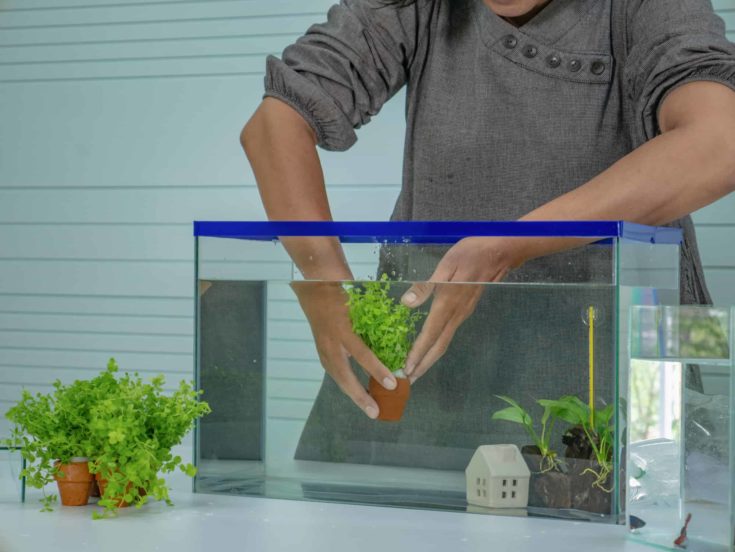
Small freshwater fish have long been popular options for community aquariums, but recently the trend for nano tanks has created new interest in these naturally tiny micro fish. Maintaining a nano tank is easier than ever before, and I’ll explain how to set one up and point you to a list of the best fish for tiny tanks!
What Are Nano Tanks?
One thing that may be confusing is that there is no strict or agreed-upon definition for what makes an aquarium a nano tank. Some folks use “nano” to refer to any small aquarium, while others use it specifically for small planted tanks designed like miniature ecosystems.
I’ve noticed that Europeans usually consider any tank under 100-gallons to be a nano tank, while in the US it’s a more commonly used term for tanks under 30-gallons. So the size of a nano tank may vary considerably around the world and the term may have different meanings depending upon where you live.
I’m going to stick with the most modern use, so when I say “nano tank” I mean a planted aquarium from 5 to 30-gallons. But there is more to building a nano tank than just picking the capacity of your aquarium. Nano tanks are designed around the plants and decor, with a few fish chosen for their color and movement.
Nano Tank Basics: Fish Keeping In Small Aquariums

It used to be difficult to maintain really small planted tanks unless you changed the water several times a week. Even a few fish could overwhelm the system and cause spikes of toxic ammonia. Advances in filtration and lighting technology have made the maintenance easier, and these tiny habitats have jumped in popularity as a result!
Nitrogen Cycle Of Nano Tanks
Your tank’s water quality depends in part on colonies of good aquarium bacteria that become established in your substrate (and 3-stage filter as well). Bacteria is an essential part of the nitrogen cycle that turns toxic ammonia from fish waste into the nitrates your plants can use for food.
Maintaining your water quality in a nano set-up can be harder than a larger aquarium because the toxins often build up faster than the bacteria can break them down. When a small tank crashes from ammonia overload it usually happens really fast, and you can start losing plants and fish within a few hours.
Just as with larger tanks, it can take up to three months for this cycle to get established in a nano tank. To prevent problems with ammonia spikes, I recommend giving your plants a few months to establish themselves before you begin putting fish in the tank, and add them gradually so you don’t throw the balance off.
Choosing A Filtration System

Aquarium filters are a must for nano tanks since they remove excess ammonia and keep your water clear and clean. Aquatic plants are actually pickier about their water quality than most species of fish! Using a high-quality filtration system like an internal, submersible or HOB will protect against sudden changes in your water quality.
Plants And Decor
Nano tanks are usually designed to mimic a natural habitat like a river or lake bottom and are a great place to start if you have an interest in aquascaping. The focus of the tank is on the live plants and decorations such as rocks, sticks, logs, and other natural materials that create the atmosphere you’re aiming for.
Nano tanks don’t even have to house fish at all, though a few fish are usually added to complete the look and bring some color to the tank. It’s not uncommon for these tanks to have only a solitary Betta fish or a few algae-eating shrimp or snails!
Lighting Systems
After choosing your filtration system, the most important decision you’ll make when designing a nano tank is picking out a light fixture. Modern aquarium LEDs are a great option for lighting nano tanks because their compact size won’t dominate the tank but still provide the spectrums of light plants need to thrive.
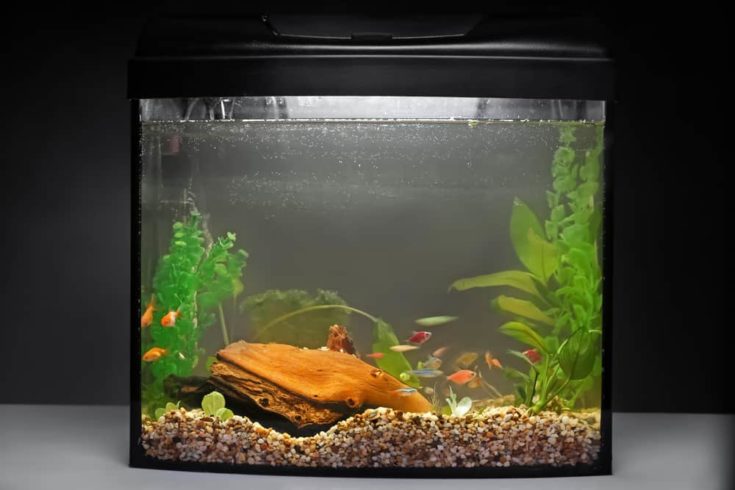
You may not need a light for your tank, but using one will give you more leeway in choosing your vegetation. You won’t be limited to easy, low-light plants when you have a quality light fixture, and your plants will be better able to use the extra nutrients provided by the decomposing fish waste!
Temperature And Heating
Depending on the temperature range of your home and the type of aquatic animals you’d like to keep, you may not need an aquarium heater in your nano tank. Some cold water nano fish do fine in room temperature water. But many fish get stressed when their temperature shifts more than a few degrees in a few hours.
I still recommend using a heater in nano tanks that house fish to prevent these sudden shifts that can cause stress and illness. Most micro fish prefer warmer water, so you’ll have a lot more options to choose between if you use a heater to maintain a stable temperature.
Aquarium Substrate
Your aquarium substrate does more than make your tank look nice; the substrate supports the good bacteria that breaks down ammonia and provides nutrients and minerals for lush plant growth. Choosing the right substrate to support your plants and fish is key to having a thriving nano tank!
Gravel
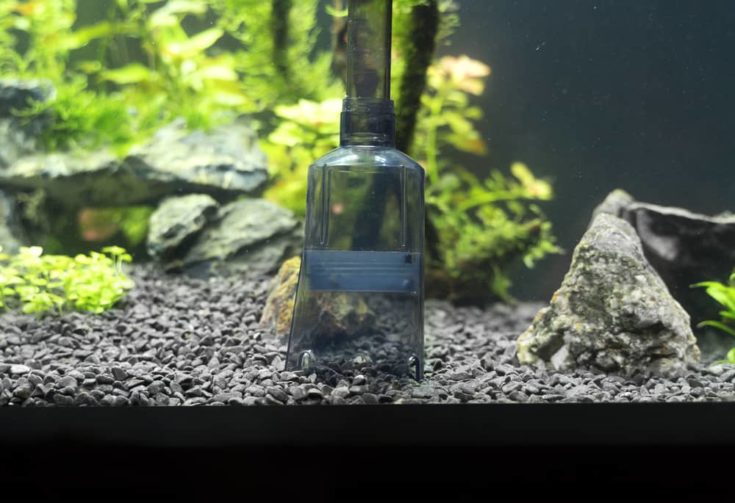
Gravel substrates for planted tanks may be fine or coarse and come in a variety of natural shades and colors from black to earth tones. Avoid using the brightly-colored neon substrates and choose a type that fits the natural look of your tank. I highly recommend using gravel that enhances plant growth!
Your fish may be less fussy about your substrate depending on where they spend their time in your tank. Top dwelling freshwater fish rarely hang out in the lower portions of your tank, but your bottom-dwelling species like catfish may prefer fine gravel or sand over a coarser, rockier type that can hurt their delicate barbels.
Sand
While sand looks fantastic and fits the natural theme, I don’t consider it an ideal primary substrate for planted tanks as a rule, even though many fish prefer the soft texture. Sand is devoid of nutrients and minerals, and often develops dead zones that can harm good aquatic bacteria, plants, and fish.
Using sand on the top layer or for special effects is fine, but I’d stick with a better plant-supporting media for your lower layers. Or hide pockets of aquatic soil or gravel in parts of your tank and use sand to create a river effect between them.
Aquatic Soil
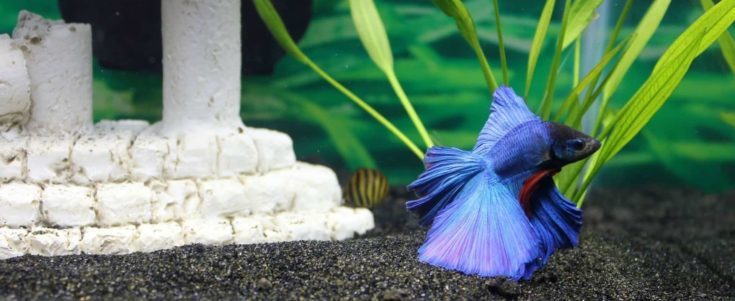
Aquarium soils are an ideal option for nano tanks. These extremely fine natural or artificial substrates are often packaged along with water that contains good aquarium bacteria to jump-start your nitrogen cycle. You don’t need to rinse or prepare these soils before adding them to your tank and your plants will likely thrive in them!
Tips For Choosing Fish For Tiny Tanks
Now that you’ve got the dirt on setting up a nano tank and enhancing your plant growth with the right substrate, lights, and filtration, let’s talk about how to select fish for your new aquarium. What qualities should you look for when stocking your tank?
In general, the best options for nano tanks are fish that:
- Are small in size and don’t produce a lot of biowaste (approximately 1 to 3-inches and no more than 5-inches in length at maturity)
- Prefer planted or densely planted tanks with lots of hiding spots
- Are peaceful in temperament or, if aggressive, can be kept happy as a solitary fish
- Won’t devour or uproot your plants for fun
- Don’t mind being kept solo or in small groups

I’ve seen a lot of sites that tout nano schooling fish for micro tanks. A big school of tetras or corydoras swimming together can make a dramatic impact! But most schooling and shoaling fish only exhibit the behavior in large groups. Nano tanks rarely have room to support the numbers needed for them to exhibit this behavior.
Best Fish For Small Tanks: 21 Freshwater Micro Fish That Stay Small
What types of small freshwater fish should you consider for your nano tank? You have a lot of options, but these species are especially suitable for small planted tanks and many do well without extra heat in their habitats! Ranging from common to exotic, here are the best tiny fish for nano tanks!
Betta
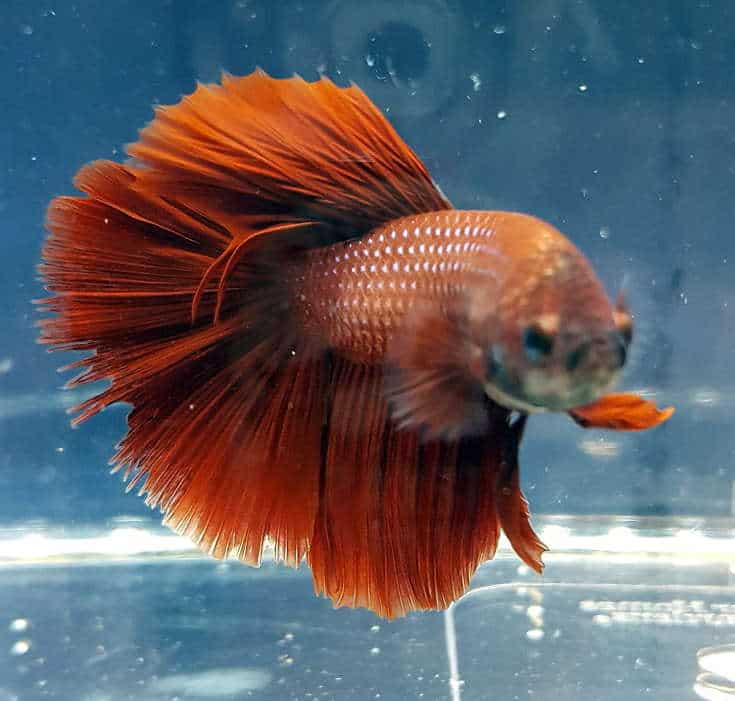
The beautiful Betta fish makes an excellent option for nano tanks, and these are some of the easiest fish to care for and an ideal pick for beginners. While male Bettas are known for being aggressive and fighting with each other, they do well as a solitary fish or when kept with a few similar-sized small-finned fish.
Female Bettas can share a tank together in a sorority, although you should aim to keep at least 3 to prevent direct competition. You can also keep a female as a solitary fish or with a few peaceful community fish. Both genders look fantastic in a planted tank and enjoy snacking on the leaves and algae.
Common Name (Species)
Betta, Siamese Fighting Fish (Betta splendens)
Care Level
Easy
Temperament
Varies by gender; ideal as a solitary fish
Diet
Omnivore
Average Adult Size
Females 3.5 inches in length
Males 5 to 5.5 inches in length, depending on variety
Minimum Tank Size
5 to 10 gallons
Temperature
75 to 86°F
pH
6.0 to 8.0
Schooling/shoaling species?
No
Guppy
If you’d like a group of active micro fish with a wide variety of colors and patterns, then consider getting some guppies for your nano tank. These easy-going fish are sexually dimorphic like the Betta but completely non-aggressive. Male fish are smaller than the plain females and flash their bright colors as they zip around!
Fancy Guppy

It’s probably no surprise that the Fancy Guppy has long been one of the most popular choices for small aquariums. They are one of the larger guppies and male fish have elongated, fan-shaped tails covered with splashes of bright colors and interesting patterns. Female’s may show hints of color or patterns too.
Common Name (Species)
Fancy Guppy (Poecilia reticulata)
Care Level
Easy
Temperament
Peaceful and active
Diet
Omnivore
Average Adult Size
1 to 2.5 inches in length (females are larger)
Minimum Tank Size
10 gallons
Temperature
75 to 82°F
pH
5.5 to 8.5
Schooling/shoaling species?
Yes, but only in larger groups (5 to 10)
Endler’s Guppy
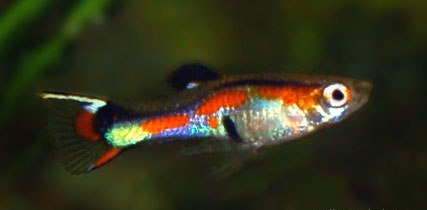
Endler’s guppies are closely related to the Fancy Guppy but look like their wild ancestors in Trinidad. While some sites still list them as a separate species (Poecilia wingei), scientifically they are considered the same as the fancies and will freely interbreed with them.
Endler’s are smaller and more agile than fancy guppies, and they are quite active in a nano tank. Male fish have short, slightly pointed tails and dots of bright red, blue, orange and black markings while the females are a rather flat grey to brown color.
Common Name (Species)
Endler’s Guppy, Endler’s Livebearer (Poecilia reticulata)
Care Level
Easy
Temperament
Peaceful and active
Diet
Omnivore
Average Adult Size
1 to 1.5-inches (females are larger)
Minimum Tank Size
5 gallons
Temperature
64 to 82°F
pH
5.5 to 8.5
Schooling/shoaling species?
Yes, but only in larger groups (5 to 10)
White Cloud Minnow

A pretty option for the middle of your tank, the streamlined White Cloud Minnow adds a nice touch of color with their iridescent pink and green scales. These tiny fish are ideal for nano tanks but are often a bit timid when kept in groups fewer than 5. The more minnows you have, the more active and outgoing your group will be!
Want to know what to feed them? Read our article on what freshwater minnows eat.
Common Name (Species)
White Cloud Minnow, Cardinal Fish (Tanichthys albonubes)
Care Level
Easy
Temperament
Peaceful; Often timid in small groups
Diet
Omnivore
Average Adult Size
1 to 1.5 inches in length
Minimum Tank Size
5 gallons
Temperature
64 to 72°F (tolerates up to 78°)
pH
6.0 to 8.0
Schooling/shoaling species?
Yes, but only in large groups (10+)
Celestial Pearl Danio
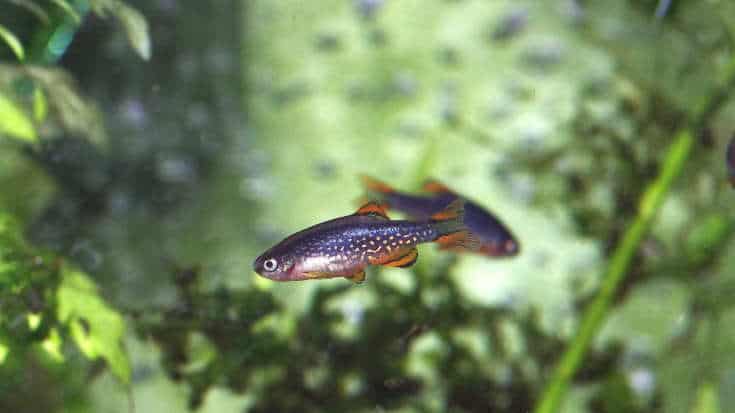
The Celestial Pearl Danio adds an impressive amount of color and movement to tiny planted tanks, and their white spotted bodies and red or orange fins pop against the vegetation! Male fish are more brightly colored and may compete over mates, so limit their numbers to keep your tank peaceful, and provide plenty of hiding places.
Common Name (Species)
Celestial Pearl Danio, Galaxy Rasbora (Danio margaritatus)
Care Level
Moderate
Temperament
Peaceful, active and shy; Male fish may compete for mates, so it’s best to limit their numbers and have 3 to 5 females per male
Diet
Omnivore
Average Adult Size
Up to 1 inch in length
Minimum Tank Sizes
10 gallons
Temperature
73 to 79°F
pH
6.5 to 7.5
Schooling/shoaling species?
Yes, in groups of 5 or more
Zebra Danio

The Zebra Danio is one of the most-researched species in the world and makes an ideal option for community aquariums. These fish are usually silver-colored with black stripes, but albino and other color morphs are readily available.They don’t enjoy being solitary and are happiest in groups of 15+ in larger, heavily planted nano tanks.
Common Name (Species)
Zebra Danio, Zebrafish (Danio rerio) argaritatus)
Care Level
Easy
Temperament
Peaceful and active
Diet
Omnivore
Average Adult Size
2 inches in length
Minimum Tank Sizes
10 gallons
Temperature
64 to 77°F
pH
6.0 to 8.0
Schooling/shoaling species?
Yes, but requires large numbers (15+)
Chili Rasbora

An ideal micro fish for nano tanks is the bright red Chili Rasbora. These fish have distinct black markings on their body and fins and prefer heavily planted tanks with an acidic pH. They do well in small groups and you can easily fit a school of 6 in a 5-gallon tank! You can also mix them with a community of tetras or minnows.
Common Name (Species)
Chili Rasbora, Mosquito Rasbora (Boraras brigittae)
Care Level
Easy
Temperament
Peaceful
Diet
Omnivore
Average Adult Size
Half an inch in length
Minimum Tank Sizes
5 gallons
Temperature
68 to 83°F
pH
4.0 to 7.0
Schooling/shoaling species?
Yes
Harlequin Rasbora

A slightly more tricky option, the Harlequin Rasbora is a tall, reddish colored fish with a black triangle marking on the sides of their bodies. These fish don’t get very large, but they do need some open room in the center of the tank to swim. They make a good option for bigger nano tanks but would not work as well in the smaller set-ups.
Common Name (Species)
Harlequin Rasbora (Trigonostigma heteromorpha)
Care Level
Easy
Temperament
Peaceful; shy as solitary fish or in small groups
Diet
Omnivore
Average Adult Size
Up to 2 inches in length
Minimum Tank Sizes
10 gallons
Temperature
72 to 81°F
pH
6.0 to 7.8
Schooling/shoaling species?
Yes, but need at least 6 in a group
Neon Tetra

The ever-popular and inexpensive Neon Tetra is an excellent option for community and nano tanks. These silver, blue and red fish are sensitive to changes in their water quality and are best added a few months after cycling your tank. This is a popular choice if you’d like them to school, but you’ll need at least 15 neons in a 20-gallon set-up to see the behavior.
Common Name (Species)
Neon Tetra (Paracheirodon innesi)
Care Level
Easy
Temperament
Peaceful and active; may be shy in small numbers
Diet
Omnivore
Average Adult Size
1 to 1.5 inches in length
Minimum Tank Sizes
10 gallons, but 20 gallons is ideal for a group of 15
Temperature
70 to 81°F
pH
6.0 to 7.0
Schooling/shoaling species?
Yes, but only when kept in larger groups of 15 or more
Cardinal Tetra
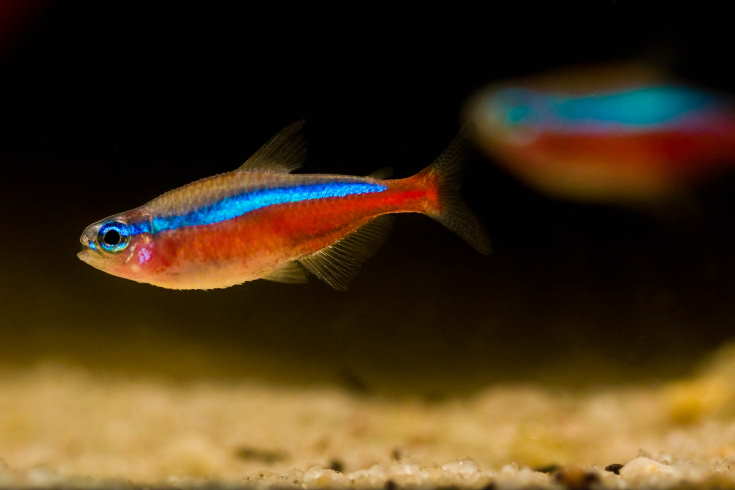
If a fish resembles a Neon but has a red stripe running the entire length of its body, then it must be the nearly-identical and closely related Cardinal Tetra. Cardinals typically grow a little larger than the neons but their care and requirements are the same. You can keep a few, but their behavior is more interesting in bigger groups.
Common Name (Species)
Cardinal Tetra (Paracheirodon axelrodi)
Care Level
Easy
Temperament
Peaceful and active; may be shy in small numbers
Diet
Omnivore
Average Adult Size
1.5 to 2 inches in length
Minimum Tank Sizes
10 gallons, but 20 gallons is ideal for a group of 15
Temperature
73 to 81°F
pH
6.0 to 7.0
Schooling/shoaling species?
Yes, but only when kept in larger groups of 15 or more
Ember Tetra

If you want to add sparks of color to your nano tank, the tiny Ember or Fire Tetra could be the choice to go with! These bright red fish thrive in densely planted environments and do well in small groups of 6 to 8. You’ll see them swimming and looking for food, and they usually stick to the center of your tank and avoid the lower and upper areas.
Common Name (Species)
Ember Tetra, Fire Tetra (Hyphessobrycon amandae)
Care Level
Easy
Temperament
Peaceful and active and playful
Diet
Omnivore
Average Adult Size
0.5 to 0.8 inches in length
Minimum Tank Sizes
10 gallons
Temperature
68 to 82°F
pH
5.5 to 7
Schooling/shoaling species?
Yes, when kept in groups of 6 to 8 or more
Bluefin Notho

If you’d like something out of the common way, then the colorful Bluefin Notho could be a unique pick for your bigger nano tank. Their red bodies are dotted with blue highlights and look amazing against your vegetation. They are a bit harder to maintain due to their limited temperature range, but overall make a great option for planted aquariums.
Common Name (Species)
Bluefin Notho, Rachovi Killifish (Nothobranchius rachovii)
Care Level
Easy to Moderate
Temperament
Peaceful
Diet
Carnivore; prefers live food
Average Adult Size
0.5 to 0.8 inches in length
Minimum Tank Sizes
20 gallons
Temperature
72 to 75°F
pH
6.0 to 7.5
Schooling/shoaling species?
No
Pygmy Corydoras
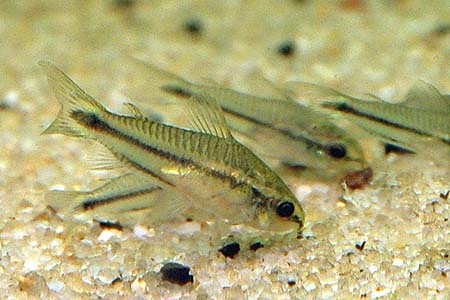
An interesting option for a bottom dwelling to mid-level fish is the Pygmy Cory Cat. These plain silver fish with black markings are one of the few catfish that school when kept in groups of 4 to 8. They are easy to care for and thrive in planted tanks. They do well as solitary fish and in mixed communities, since they get along with other species.
Common Name (Species)
Pygmy Corydoras, Pygmy Catfish (Corydoras pygmaeus)
Care Level
Easy
Temperament
Peaceful and active
Diet
Omnivore
Average Adult Size
Up to 1 inch in length
Minimum Tank Sizes
10 gallons
Temperature
72 to 79°F
pH
6.0 to 8.0
Schooling/shoaling species?
Yes, when kept in groups of 4 to 8
Sixray Corydoras

The spotted Sixray Cory Cat is a bit challenging to deal with because the rays on their dorsal fin are very sharp and can puncture the skin. You should only ever handle this fish using a plastic container for your own safety, because their spines get caught-up in nets. These small bottom feeders need a soft substrate and prefer to be kept in groups of at least 5.
Common Name (Species)
Sixray Corydoras, False Cory Cat (Aspidoras pauciradiatus)
Care Level
Moderate to Hard
Temperament
Peaceful, but sharp rays can puncture other fish accidentally so best kept as the only bottom feeder in a tank
Diet
Omnivore
Average Adult Size
0.8 to 1.2 inches long
Minimum Tank Sizes
10 gallons
Temperature
72 to 77°F
pH
6.0 to 7.2
Schooling/shoaling species?
Shoals and prefers to live in groups of 5 or more
Otocinclus Catfish

Whether you have an algae problem or not, adding Otocinclus Catfish to a nano tank makes a lot of sense. These tiny algae-eating machines are easy to care for and also munch on decaying vegetation, making them an ideal companion for cleaning a planted tank! If you keep a few Ottos together they’ll often hang out and even school!
Common Name (Species)
Otocinclus Catfish, Ottos, Dwarf Sucking Catfish
(multiple species including Otocinclus vestitus)
Care Level
Easy
Temperament
Peaceful and active
Diet
Herbivore; eats mostly algae and decaying leaves
Average Adult Size
1 to 2 inches in length
Minimum Tank Sizes
10 gallons
Temperature
72 to 82°F
pH
6 to 7.5
Schooling/shoaling species?
Yes, when kept in groups of 4 to 6
Salt and Pepper Catfish

If you’d like some little fish with outgoing personalities, then consider a group of Salt and Pepper Cory Cats for your bigger nano tank! These silver and black bottom dwellers are one of the smallest and most social of catfish, and love to explore your plants and decor. They are easy to care for in groups of 6 to 8 and make an ideal pick for community tanks 15-gallons and up!
Common Name (Species)
Salt and Pepper Catfish, Salt and Pepper Cory Cat
(Corydoras habrosus)
Care Level
Moderate
Temperament
Peaceful, active and social; best kept in groups of 6 or more
Diet
Omnivore
Average Adult Size
1 to 1.5 inches
Minimum Tank Sizes
15 gallons
Temperature
71 to 84°F
pH
6.0 to 7.7
Schooling/shoaling species?
No
Asian Stone Catfish
Another unique bottom feeder is the prickly Asian Stone Catfish. These interesting brown, tan and black fish are covered with long pectoral spines and blend into the environment in your tank. They do a great job cleaning food scraps from the substrate and prefer to live in small groups of three or more. They are best kept as the only bottom dwellers, though, since bigger fish may eat all their food.
Common Name (Species)
Asian Stone Catfish, Dwarf Moth Catfish (Hara jerdoni)
Care Level
Easy
Temperament
Peaceful scavenger
Diet
Omnivore
Average Adult Size
Up to 1.5 inches in length
Minimum Tank Sizes
5 gallons
Temperature
64 to 75°F
pH
5.6 to 7.6
Schooling/shoaling species?
No
Pea Puffer Fish

I’ve always been fascinated with Puffer Fish, and the tiny Pea or Dwarf Puffer is an excellent option for a nano tank! These small fish do best as the only species in the tank, since male fish are very aggressive and territorial. They enjoy interacting with each other, so it’s best to keep a single male with a bigger group of female fish, regardless of your tank size.
Common Name (Species)
Pea Puffer Fish, Dwarf Puffer Fish
(Carinotetraodon travancoricus)
Care Level
Moderate to Hard
Temperament
Males are aggressive and territorial; females are peaceful and social. Best to keep 1 male per tank with at least 3 female fish
Diet
Mostly carnivorous
Average Adult Size
1 to 1.4 inches in length
Minimum Tank Sizes
5 gallons
Temperature
77 to 79°F
pH
6.5 to 7
Schooling/shoaling species?
No
Sparkling Gourami
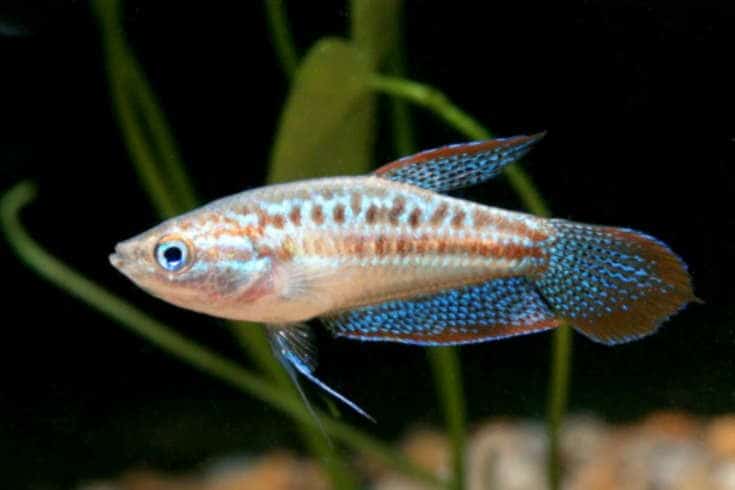
If you’d like fish that glimmer like jewels as they swim through your plants, then the bright and Sparkling Gourami could be the pick for your nano tank! These iridescent fish are primarily brown but their scales give them a shimmering appearance as they move through your tank. They prefer to be kept in groups with a single male and several females.
Common Name (Species)
Sparkling Gourami, Pygmy Gourami (Trichopsis pumila)
Care Level
Easy to Moderate
Temperament
Peaceful and active, but males can be territorial with each other. Best kept in groups of 5 or more with a single male and multiple female fish
Diet
Omnivore
Average Adult Size
Up to 1.6 inches long
Minimum Tank Sizes
15 gallons
Temperature
771 to 80°F (77°F is ideal)
pH
6.0 to 8.0
Schooling/shoaling species?
No
Licorice Gourami
https://www.youtube.com/watch?v=axYOi7xMYAc
The brown, white and blue Licorice Gourami is another stand-out option for a nano tank. These fish are more timid than the Sparkling variety and do well in pairs or groups, although it’s usually best to only keep a single male in the tank to prevent competition. They are picky eaters which makes them a poor choice for community aquariums.
Common Name (Species)
Licorice Gourami (Parosphromenus deissneri)
Care Level
Moderate
Temperament
Peaceful and timid, but males can be territorial with each other. Best kept in pairs or groups of 3 or more with a single male and multiple female fish
Diet
Omnivore; prefers live or frozen diets over flake foods and can be a picky eater
Average Adult Size
1.2 to 1.6 inches in length
Minimum Tank Sizes
5 gallons for a pair
Temperature
72 to 82°F
pH
3.0 to 6.5
Schooling/shoaling species?
No
Bumblebee Goby

Consider yourself lucky if you come across the bright gold and black Bumblebee Goby in your local aquarium shop! These rare fish are hard to find, but they are an interesting addition to a community tank. They are very active and like to explore, though they can be territorial with each other. It’s usually best to keep a single goby in a nano tank unless your aquarium is large enough for at least 6 (55 to 75 gallons).
Common Name (Species)
Bumblebee Goby (Brachygobius xanthomelas)
Care Level
Moderate to Hard
Temperament
Peaceful and active; can be territorial with each other so best to keep one per tank
Diet
Carnivore; prefers live or frozen foods and can be a picky eater
Average Adult Size
1 to 1.2 inches in length
Minimum Tank Sizes
10 gallons
Temperature
72 to 84°F
pH
7.0 to 8.5
Schooling/shoaling species?
No
Conclusion
As nano tanks become more trendy and popular there’s been increased interest in the small species of fish that thrive in these densely planted habitats. Tiny fish make great additions to small tanks and many do well in solitary or small group settings.
Whether you opt for a few common Neon Tetras or want an exotic Pea Puffer Fish, I hope this guide to Nano Tank Fish has helped you find the perfect options for your planted tank! We’d love to hear about your set-up in the comments, or follow us on social media!
Check out our infographic and don’t forget to share!
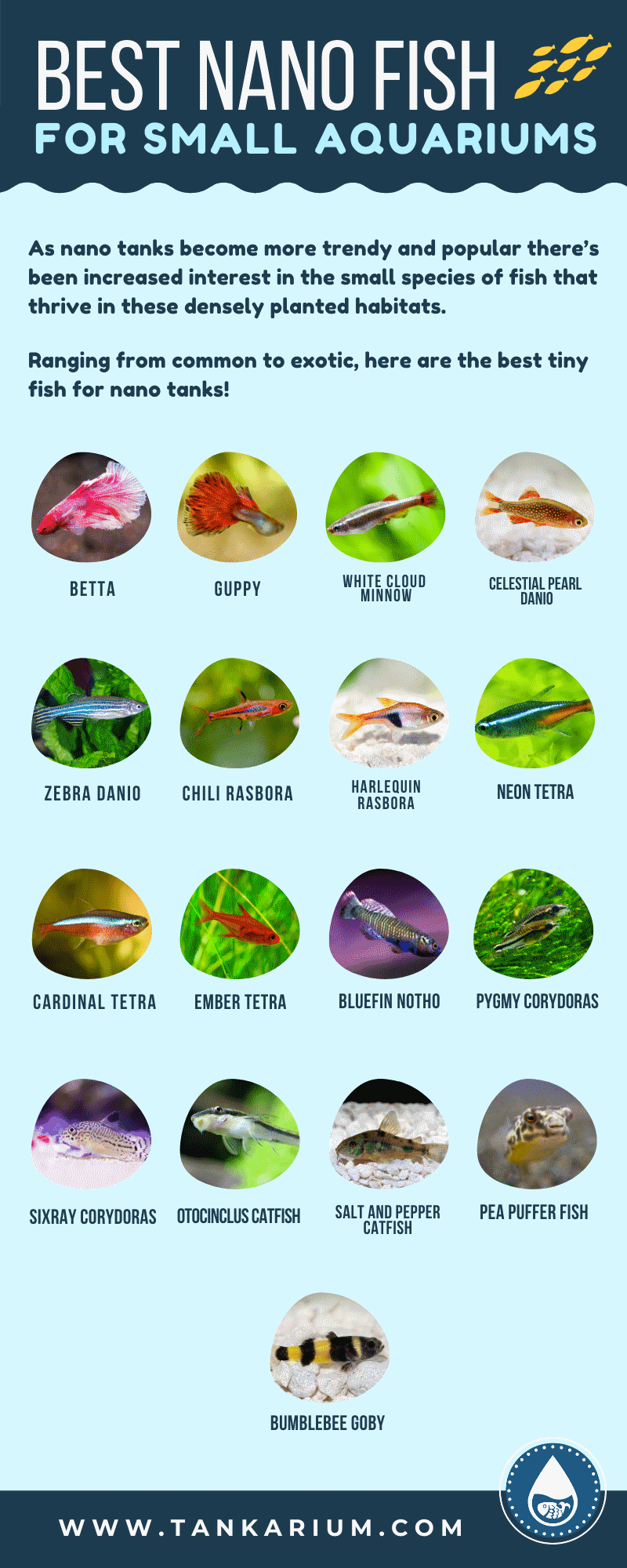

Pretty good selection of fish, I would add the scarlet badis as well. I do disagree with your definitions of nano – I’ve been in the aquarium hobby for over 35 years now, and been keeping nano tanks for the last 9 years, and I’ve never heard anyone refer to a tank as large as a 20 gallon as a “nano”. Mostly I see nano as referring to 5 and under, and I’ve not seen nano restricted, or even mostly referring to planted tanks. Many people I know who have nanos have shrimp-only setups like a 3.5 gallon Fluval Spec set up with just sand and spider wood.